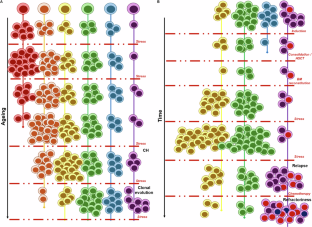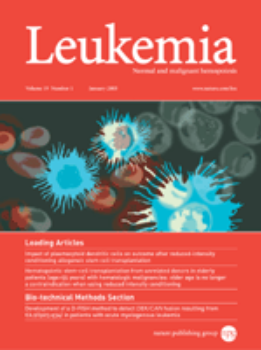How fast does leukemia progress?
IF 12.8
1区 医学
Q1 HEMATOLOGY
引用次数: 0


白血病的进展有多快?
在健康的人类细胞中获得体细胞突变是普遍存在的,并且与年龄有关,尽管可以增加患癌症和非恶性疾病以及全因死亡率的风险。体细胞突变导致克隆群体的遗传分化和干细胞池多样性的降低,这一过程被称为克隆造血(CH)[2]。造血干细胞(hsc)在整个基因组中每年可获得20个体细胞突变,在蛋白质编码外显子中每年可获得0.1个突变。如果突变提供了一种选择优势,那么携带这种改变的造血干细胞就会扩张,这种现象被称为克隆进化,在衰老过程中很常见。克隆进化被定义为从肿瘤异质性中对特定癌细胞群的选择,被认为是一种类似达尔文的模型,可以解释肿瘤细胞在持续的外部选择压力(如免疫监视bbb)下存活的过程。目前,最被接受的模型是分支进化,其中一个共同的祖先产生了多个共存的克隆,并在获得额外突变的同时分化和进化。CH常见于衰老、非血液学疾病(如心血管疾病)和几种血液学疾病,包括意义不确定的单克隆伽玛病。然而,其临床意义尚不清楚,因为突变随着年龄的增长而积累,被认为是健康和癌前造血bbb的分子钟。CH的起源和随后的动态是基因型特异性的,因为一些克隆可能自发消失。例如,dnmt3a突变克隆在青年时期迅速出现,而在成年和老年时期缓慢出现,通常被TET2-或剪接因子突变的CH所取代。克隆适应性也依赖于环境。化疗和放疗是主要的选择压力,强烈影响基因型依赖性克隆扩增、优势或消耗[7],因为在接受化疗/放疗的个体中,TP53、PPM1D和CHEK2克隆生长更快[8]。此外,VAF阈值≥2%被提议作为克隆进化的截止值:当CH克隆达到该值时,它们更常与恶性和非恶性结局相关[9]。CH是一个不断演变的概念,从严格的肿瘤性到更动态和进化的框架,它可能反映了骨髓(BM)中某一时刻的干细胞池多样性,就像panta rei造血的快照。传统上,克隆进化被定义为在持续的外部压力下,恶性克隆的选择,最终导致癌症。然而,随着下一代测序(NGS)的常规使用,CH经常与衰老和一些慢性疾病一起被发现,而不伴有癌症疾病[10],因为克隆动力学可受到dna损伤刺激和应激造血[11,12]。携带致病变异的克隆,可能在骨髓中随机发生,可能在数年内保持静止或最低限度的增殖,并且只在某些压力下扩张,例如感染或hsc输注[13]。在卵巢癌中,经过HSP90或PARP抑制剂治疗后,TP53-和ppm1d突变的克隆比DNMT3A-或tet2突变的克隆扩展得更快。此外,DNA损伤反应(DDR)基因体细胞突变和同源重组基因种系突变同时发生的克隆,其增殖能力也会降低。在这些应激事件中,一旦这些条件消退,克隆会暂时出现,并在检测水平下恢复,如在HSC移植(HCT)或急性髓系白血病(AML)复发后的BM重建中所观察到的[11,14,15]。在重组过程中,受者平均获得~23个突变,相当于~1.5年的衰老,其中DNMT3A和TET2[11]的驱动突变。同样,与诊断相比,DNMT3A、TP53、TET2以及RUNX1、flt3 -酪氨酸激酶结构域、PTPN11、IKZF1、KIT[15]在AML复发中更常见,反映了应激[11]下,适应型克隆的优先生长。然而,健康并不总是与有效的造血相关,年龄较大的供体来源的干细胞往往表现出谱系偏差和对压力的反应能力差,导致无效的造血bb0。
本文章由计算机程序翻译,如有差异,请以英文原文为准。
求助全文
约1分钟内获得全文
求助全文
来源期刊

Leukemia
医学-血液学
CiteScore
18.10
自引率
3.50%
发文量
270
审稿时长
3-6 weeks
期刊介绍:
Title: Leukemia
Journal Overview:
Publishes high-quality, peer-reviewed research
Covers all aspects of research and treatment of leukemia and allied diseases
Includes studies of normal hemopoiesis due to comparative relevance
Topics of Interest:
Oncogenes
Growth factors
Stem cells
Leukemia genomics
Cell cycle
Signal transduction
Molecular targets for therapy
And more
Content Types:
Original research articles
Reviews
Letters
Correspondence
Comments elaborating on significant advances and covering topical issues
 求助内容:
求助内容: 应助结果提醒方式:
应助结果提醒方式:


